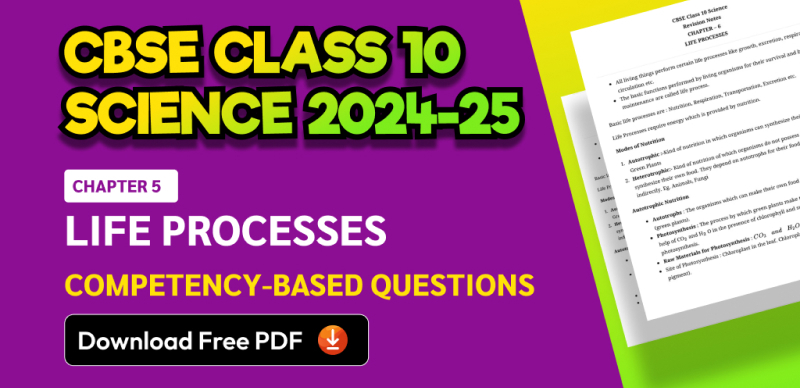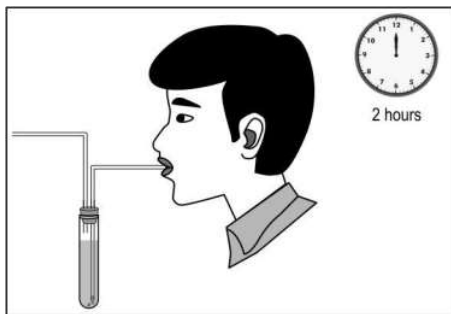CBSE Class 10 Science 2024-25: Chapter 5 Life Processes Competency-Based Questions with Answers; Download Free PDF

SHARING IS CARING
If our Website helped you a little, then kindly spread our voice using Social Networks. Spread our word to your readers, friends, teachers, students & all those close ones who deserve to know what you know now.
As the CBSE Class 10 board exams get closer, it’s important for students to understand the new exam pattern. Starting in the 2024-25 school year, CBSE will include 50% more competency-based questions. These questions will be both multiple choice and written, focusing on how to use what students have learned in real-life situations.
This article explores Chapter 5: Life processes. It highlights key competency-based questions and provides answers to help students succeed. Prepare for your CBSE Class 10 Science exams with important competency-based questions from Chapter 5: Life processes.
Understanding Competency-Based Questions in Chapter 5: Life processes
Get ready for the CBSE Class 10 Science 2024-25 exams with key competency-based questions from Chapter 5: Life processes. These questions help you apply concepts in real-life situations. Download the free PDF for detailed answers and boost your exam preparation.
CBSE Class 10 Science Chapter 4: Life processes Important Competency-Based Questions
Answer the questions based on the following information.
William Harvey (1578–1657) was one of the early biologists who studied the bodies of humans and animals. He even dissected the bodies and did experiments with the heart and blood vessels. He concluded from his experiments that the blood leaves the heart through the arteries and returns via the veins. However, he could not explain how blood left the arteriesto enter the veins. He said there must be some structure between arteries and veins but he could not find them. Marcello Malphigi (1628–1694) later discovered these structures while studying a dead frog's lungs under a microscope.
Q.1 Which of the following structures did Malphigi find in the frog?
A. cells
B. capillaries
C. heart chambers
D. small air sacs in lungs
Answer. B. capillaries
Q.2 What is the MOST LIKELY reason why Harvey could NOT find these structures?
A. These structures are not found in humans.
B. These structures are found only in the lungs.
C. These structures become visible only in dead animals.
D. These structures were too small to be seen by the naked eye.
Answer. D. These structures were too small to be seen by the naked eye.
Q.3 Which of the following statements about arteries and veins is TRUE?
A. Arteries have thicker walls than veins.
B. Veins have thicker walls than arteries.
C. All arteries carry only oxygenated blood.
D. All veins carry only deoxygenated blood.
Answer. A. Arteries have thicker walls than veins.
| Download PDF | |
| CBSE Class 10 Science Chapter 1 Chemical Reactions & Equation: Important Competency-Based Questions 2024-25 | Click Here |
| CBSE Class 10 Science Chapter 2 Acids, Bases and Salts: Important Competency-Based Questions 2024-25 | Click Here |
| CBSE Class 10 Science Chapter 3 Metal and Non-metal: Important Competency-Based Questions 2024-25 | Click Here |
| CBSE Class 10 Science Chapter 4 Carbon and its Compounds: Important Competency-Based Questions 2024-25 | Click Here |
| CBSE Class 10 Science Chapter 5 Life Processes: Important Competency-Based Questions 2024-25 | Click Here |
Q.4 Which two chambers of the human heart have arteries connected to them?
A. left atrium and left ventricle
B. right atrium and right ventricle
C. left atrium and right atrium
D. left ventricle and right ventricle
Answer. D. left ventricle and right ventricle
Q.5 Aerobic respiration requires intake of oxygen to breakdown food to release energy.
(a) Name the structuresthrough which gaseous exchange takes place in plants and human beings.
(b) Name the structure that controls the size of the chest cavity in humans to facilitate exchange of gases.
(c) What is the process by which gas exchange occurs in plants?
(d) Why is the process named in (c) not sufficient to carry oxygen throughout human body? How is this complemented in humans to ensure that oxygen is carried to all parts of the body?
(e) Reactions in living systems can absorb heat or release heat. State whether the heat energy is absorbed/ released during digestion. Also write the scientific term to denote the same.
Answer. (a) 0.5 marks for each correct answer:
Plants: stomata/guard cells
Human beings: alveoli/ lungs
(b) diaphragm
(c) diffusion
(d) 1 mark for each correct point:
- because diffusion is a slow process and human beings have complex tissues that might not allow diffusion to happen effectively and easily
- carried by the blood/ haemoglobin in the blood
(e) 0.5 marks for each correct answer:
- use up heat
- endothermic
Q6. Given below is an image of an experiment conducted by a student to understand the process of respiration. He blows into a clear solution present in the test tube and sees that it turns cloudy

(a) What is the most likely substance present in the test tube?
(b) What could be the aim of his experiment?
(c) What kind of respiration is shown in the experiment? Justify your answer.
Answer. (a) lime water / dilute aqueous solution of calcium hydroxide/ Ca(OH)2
(b) To prove that carbon dioxide is released during respiration.
(c) - aerobic respiration [0.5 marks]
- CO2 is a product of either aerobic respiration or fermentation [0.5 marks]
- fermentation does not take place in human cells. [0.5 marks]
Q: 7 We often hear people complain about 'acidity' in the stomach.
(a) Overproduction of what substance is most likely the reason for the complaint?
(b) Why is the production of this substance necessary?
(c) How does the stomach prevent itself from the harmful effects of overproduction of the substance?
Answer. (a) hydrochloric acid
(b) It creates an acidic medium for functioning of enzyme pepsin.
(c) The stomach also produces mucus that coats the lining to prevent damage by hydrochloric acid.
Q: 8 There are various muscles present in the human digestive system known as sphincters. Two examples of those are given below:
1. pyloric sphincter - at the junction of stomach and small intestine
2. anal sphincter at the anus
Give ONE most likely consequence of malfunctioning of each of these sphincters.
Answer. 1 mark for each consequence such as:
- pyloric sphincter: food getting into small intestine too fast causing poor absorption
/ poor digestion
- Anal sphincter: involuntary release of feces from the body
Q: 9 The developing human embryo gets nutrition from the mother through a special tissue called placenta.
(a) Mention TWO structural designs of the placenta that help the embryo to get nutrition.
(b) is the placental tissue designed for one way transport? Justify your answer.
Answer. (a) 1mark for each correct point:
- It has villi on the embryo side.
- It has blood spaces on the mother's side.
(b) No, the waste generated by the developing embryo is transferred out through the placental tissue.
Q: 10 Arthropods and molluscs have a copper-containing respiratory pigment called hemocyanin while human beings have iron-containing hemoglobin.
(a) How do respiratory pigments help in the process of respiration?
(b) Why do multicellular animals need a respiratory pigments?
Answer. (a) Respiratory pigments combine with oxygen and help in transport of oxygen
throughout the body.
Teacher should award marks if students have done the following:
(b) When the body size of animals is large, diffusion pressure alone cannot take care of oxygen delivery to all parts of the body. Hence, respiratory pigments take up oxygen from the air in the lungs and carry it to tissues which are deficient in oxygen.
-
👉 Read Also- CBSE Class 10 Half-Yearly/Mid Term 2024-25 : Most Important Questions with Answers; PDF Download (All Subjects)
👉 CBSE Class 10 Study Materials
| CBSE Class 10 Syllabus 2024-25 | NCERT Solutions For Class 10 |
| CBSE Class 10 Previous Year Question Papers | CBSE Class 10 Books |
| CBSE Class 10 Full Study Material | CBSE Class 10 Sample Paper |







 Profile
Profile Signout
Signout












 Quiz
Quiz
 Get latest Exam Updates
Get latest Exam Updates 










